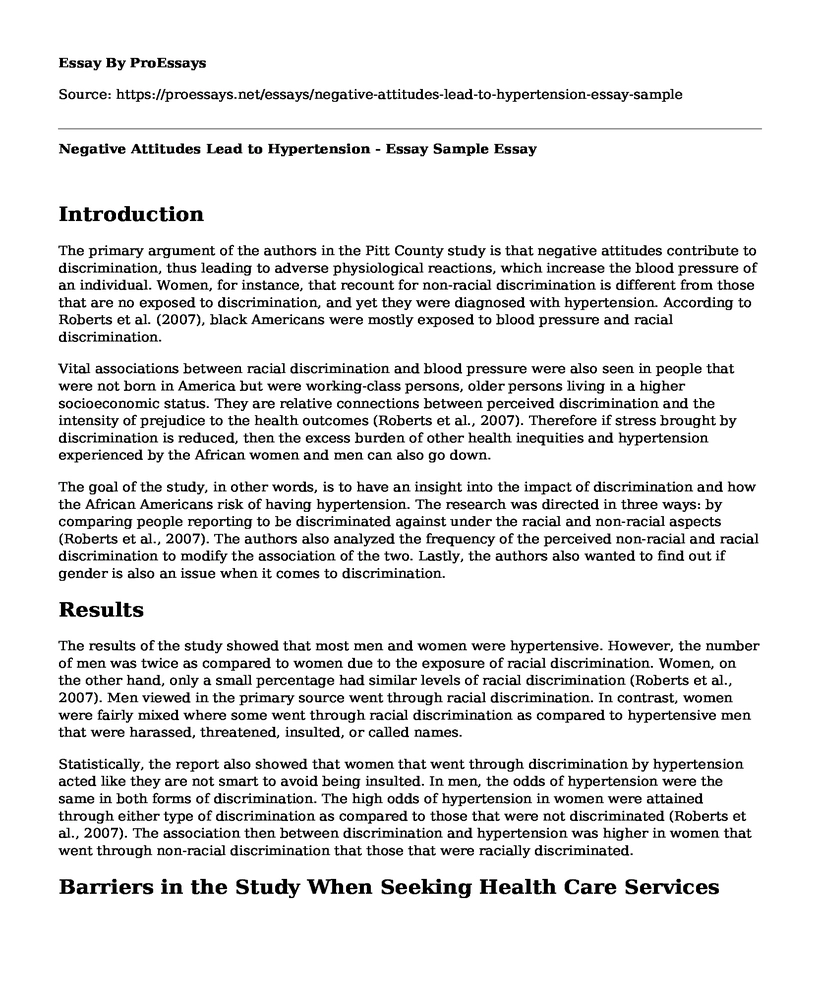Introduction
The primary argument of the authors in the Pitt County study is that negative attitudes contribute to discrimination, thus leading to adverse physiological reactions, which increase the blood pressure of an individual. Women, for instance, that recount for non-racial discrimination is different from those that are no exposed to discrimination, and yet they were diagnosed with hypertension. According to Roberts et al. (2007), black Americans were mostly exposed to blood pressure and racial discrimination.
Vital associations between racial discrimination and blood pressure were also seen in people that were not born in America but were working-class persons, older persons living in a higher socioeconomic status. They are relative connections between perceived discrimination and the intensity of prejudice to the health outcomes (Roberts et al., 2007). Therefore if stress brought by discrimination is reduced, then the excess burden of other health inequities and hypertension experienced by the African women and men can also go down.
The goal of the study, in other words, is to have an insight into the impact of discrimination and how the African Americans risk of having hypertension. The research was directed in three ways: by comparing people reporting to be discriminated against under the racial and non-racial aspects (Roberts et al., 2007). The authors also analyzed the frequency of the perceived non-racial and racial discrimination to modify the association of the two. Lastly, the authors also wanted to find out if gender is also an issue when it comes to discrimination.
Results
The results of the study showed that most men and women were hypertensive. However, the number of men was twice as compared to women due to the exposure of racial discrimination. Women, on the other hand, only a small percentage had similar levels of racial discrimination (Roberts et al., 2007). Men viewed in the primary source went through racial discrimination. In contrast, women were fairly mixed where some went through racial discrimination as compared to hypertensive men that were harassed, threatened, insulted, or called names.
Statistically, the report also showed that women that went through discrimination by hypertension acted like they are not smart to avoid being insulted. In men, the odds of hypertension were the same in both forms of discrimination. The high odds of hypertension in women were attained through either type of discrimination as compared to those that were not discriminated (Roberts et al., 2007). The association then between discrimination and hypertension was higher in women that went through non-racial discrimination that those that were racially discriminated.
Barriers in the Study When Seeking Health Care Services and Medical Treatment
When women's health was analyzed, it was noticed that they received unfair treatment that never correlated with their diastolic blood pressure or systolic blood pressure, particularly for African-America (Roberts et al., 2007). Every day, they went through unfair treatment because of their race and other factors. Another barrier is that unfair treatment was perceived due to their height, weight, gender, and age. The authors also researched the interactions between the covariates and the main exposure and discovered it was statistically non-significant. When interactions involving socioeconomic status are absent, then the insufficiency of the economic diversity made it impossible for treatment.
Two Health Care Policies That Can Be Implemented
The first policy is the communities of the opportunity to minimize systemic racism. When the societies are provided with early childhood resources, then the implemented policies to submit work reduce poverty, and support adults financially will straighten the system. The second policy is the emphasis of high-quality care for the African Americans that address the social needs of the patients, strengthens the preventive health care approach, and diversifies the health care workers to reflect more on the demographic status of the patients.
References
Roberts, C. B., Vines, A. I., Kaufman, J. S., & James, S. A. (2007). Cross-Sectional Association between Perceived Discrimination and Hypertension in African-American Men and Women. The Pitt County Study, 167(5), 624-632. Doi: DOI: 10.1093/aje/kwm334
Cite this page
Negative Attitudes Lead to Hypertension - Essay Sample. (2023, May 22). Retrieved from https://proessays.net/essays/negative-attitudes-lead-to-hypertension-essay-sample
If you are the original author of this essay and no longer wish to have it published on the ProEssays website, please click below to request its removal:
- Nutritional Benefits for Breast Milk Paper Example
- My Career Choice: Nursing Paper Example
- Social Problems and Social Work Essay Example
- Is Addiction A Disease or A Choice? - Essay Sample
- Effect of my Physical Therapy Experience to my Personal Growth: Personal Statement
- Essay Sample on Governor Parson & President Obama Address Corona & Ebola
- Exploring the Relationship Between Oral Hygiene & Wearing Gold Grills - Research Proposal







